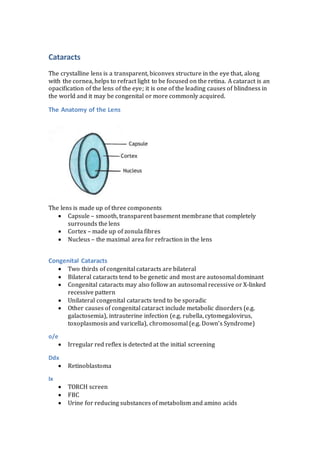
Cataracts
- 1. Cataracts The crystalline lens is a transparent, biconvex structure in the eye that, along with the cornea, helps to refract light to be focused on the retina. A cataract is an opacification of the lens of the eye; it is one of the leading causes of blindness in the world and it may be congenital or more commonly acquired. The Anatomy of the Lens The lens is made up of three components Capsule – smooth, transparent basement membrane that completely surrounds the lens Cortex – made up of zonula fibres Nucleus – the maximal area for refraction in the lens Congenital Cataracts Two thirds of congenital cataracts are bilateral Bilateral cataracts tend to be genetic and most are autosomal dominant Congenital cataracts may also follow an autosomal recessive or X-linked recessive pattern Unilateral congenital cataracts tend to be sporadic Other causes of congenital cataract include metabolic disorders (e.g. galactosemia), intrauterine infection (e.g. rubella, cytomegalovirus, toxoplasmosis and varicella), chromosomal (e.g. Down’s Syndrome) o/e Irregular red reflex is detected at the initial screening Ddx Retinoblastoma Ix TORCH screen FBC Urine for reducing substances of metabolism and amino acids
- 2. CT brain scan Hearing tests Tx Cataract is removed by phacoemulsification at 4-6 weeks to prevent amblyopia Glasses or contact lenses may be needed later in life to correct vision If unilateral physical occlusion of the bad eye or atropine penalisation of the stronger eye can prevent amblyopia Acquired Cataracts Most common cause of cataract is natural ageing May be secondary to systemic diseases such as; diabetes, muscular dystrophy, neurofibromatosis or atopic dermatitis May also occur secondary to ocular diseases such as; chronic anterior uveitis, high myopia, fundus dystrophy or acute angle closure glaucoma Exposure to sunlight, cigarette smoke, radiation, chronic dehydration, corticosteroids and antipsychotics also increase the likelihood to acquire cataracts o/e Patients complain of reduced visual acuity, increased glare in low light, myopic shift and diplopia Ddx Traumatic Cataract Ix Direct and indirect ophthalmoscopy Check for co-morbidities such as diabetes Tx Treatment of choice is phacoemulsification Indications for surgery include low visual acuity impacting on activities of daily living An appropriate artificial lens is inserted into the preserved capsule during the operation Although vision will be good, this artificial lens can not accommodate therefore spectacles are needed for near vision Traumatic Cataracts Most common cause of acquired unilateral cataracts in the young Cataracts produced tend to be irregularly shaped and colourful Caused by; penetrating trauma, blunt trauma, electricity and infrared/ionizing radiation. Managed conservatively unless the cataract obstructs field of vision If the capsule is no longer intact phacoemulsification is contraindicated